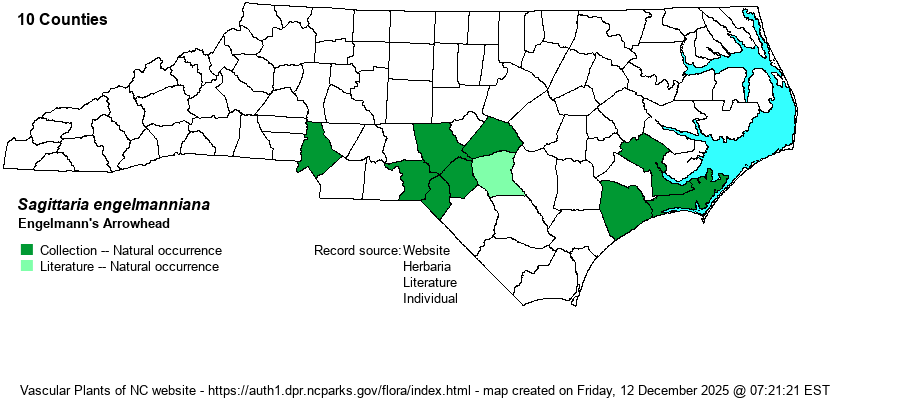| Author | J.G. Smith | |
| Distribution | In NC found mostly in the Sandhills region; disjunct farther east to Craven, Carteret, and Onslow counties. A SERNEC specimen (at NCU) from Mecklenburg County is the only record outside the Coastal Plain.
This is a mainly Coastal Plain species, primarily of the Atlantic Coastal Plain, ranging from MA and NY south to northern FL and west to MS. It has not been recorded in TN, KY, or WV.
| |
| Abundance | Infrequent to locally fairly common in the Sandhills, but mostly rare elsewhere in the southern Coastal Plain. Very rare elsewhere in the state, though it could occur in the northern Coastal Plain as it ranges far to the north of NC. The NCNHP considers it as a Watch List species. | |
| Habitat | This Sagittaria species favors strongly acidic wetlands, usually in full sun. It occurs along blackwater streams and streamheads, beaver ponds, and impoundments, especially when water levels recede. |
| Phenology | Blooms from June to October, and fruits shortly after blooming. | |
| Identification | This is one of just several arrowhead species with truly arrowhead-shaped leaf blades. In this species, the blade is typically much narrower than in the common S. latifolia and the infrequent S. australis. Those two have a roughly broadly triangular blade, but this species has a "skinny" leaf that may be up to 8 inches long but barely 1-2 inches wide, with the two basal lobes being less than 1 inch wide and quite acute in shape. The flowering stem can be up to 1.5 feet long, but this species has flowers in just 2-4 whorls, instead of normally 4-12 or more whorls in the other two species. Each flower has 3 white petals and can be 1 inch across. This species should be readily identified just by its very slender leaf shape, and walking around the shores of sandhills ponds might yield this species. | |
| Taxonomic Comments | This has always been a good species, but some references have included S. australis (= S. longirostra) within it. Most references have these entities now split out; in fact even RAB (1968) had them as good species, but the latter was named as S. longirostra.
| |
| Other Common Name(s) | None | |
| State Rank | S2 | |
| Global Rank | G4 | |
| State Status | W1 | |
| US Status | | |
| USACE-agcp | OBL link |
| USACE-emp | OBL link |

